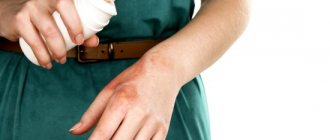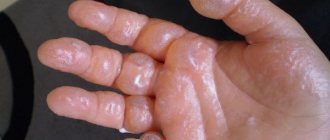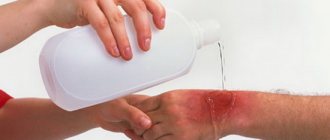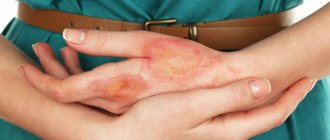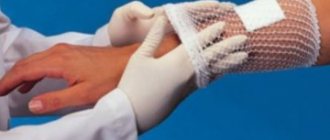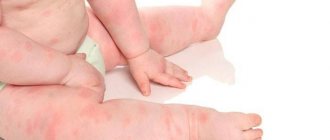Steam burns are a fairly common injury. It usually affects women or children. It's easy to get. To do this, you just need to hold your hand close over the boiling water in the pan. Almost everyone has experienced this. Initially, such exposure does not pose a threat, but you need to know what to do in case of a steam burn and what is best to use to treat the injury. In case of injury, it is necessary to provide assistance to the victim in a timely manner. The speed of restoration of the epidermis will depend on the correctness of assistance.
Why is a steam burn more dangerous than an injury from hot water?
To judge the severity of the injury. It is necessary to find out what the damaging factor is. This substance is formed as a result of heating a liquid. At first glance, it seems that steam is not so dangerous. But the injuries caused by it can be much more serious than those caused by hot water. This is due to the following reasons:
- The boiling point of water under normal conditions is 100; when this temperature is exceeded, it transforms into another state of aggregation - steam. The temperature of boiling water is quite high.
- When water hits the surface of the skin, a cooling effect occurs due to the thermoregulation of our body. Steam, on the contrary, provokes the release of even more heat, increasing the temperature of the epidermis. It remains on the skin, flowing down in drops.
Traditional medicine
In the arsenal of traditional medicine there are many time-tested ways to alleviate the consequences of burns.
As first aid for adults and children using folk remedies, to relieve redness and reduce pain, you can apply a paste of raw potatoes with the addition of honey to the damaged area.
Raw egg yolk works well to prevent the formation of bubbles; it should be beaten and gently applied to the burn. The amino acids it contains also promote rapid healing.
An excellent remedy for stimulating skin regeneration is aloe; a pulp of its leaves is applied to the affected area several times a day for 15-20 minutes.
What is the danger?
When you receive a steam injury at home, as with any other thermal injury, the outer cells of the epidermis die and stagnation in the blood flow occurs. This injury is accompanied by redness of the skin and swelling. Nerve endings that have been exposed to a damaging factor send strong pain impulses. To quickly help the victim, it is necessary to determine the severity of the injury.
Lesions that people receive at home can be divided into 3 degrees of severity:
- Mild - the victim experiences redness of the epidermis, the affected area is swollen. The person experiences pain that worsens with pressure;
- Medium - blisters form on the skin, which are filled with tissue fluid inside;
- Severe - necrosis of individual tissues occurs. Peeling of the upper tissues is observed. During the recovery period, a scar forms.
With a third-stage steam burn, the patient may lack sensitivity in this area. This is because most of the cells die. If you experience such symptoms, you should immediately seek help from a hospital. Surgery may be required to prevent the development of gangrene. Also an important factor in determining the extent of damage is the area of thermal damage.
To determine this, the “palm rule” is used: the palm is taken as 1% of the body surface. The rule of nines is also sometimes used:
- the epidermis of the breast and skin makes up 18%;
- each lower and upper limb 18%;
- neck with head - 9%.
If more than 15% of the epidermis is affected, you should immediately consult a doctor. If a large area is affected, then signs of intoxication appear.
If more than half of the skin is damaged, there is a risk of death, so you should not try to help yourself.
Correct determination of the degree of damage will determine the tactics of providing care for burns.
Treatment
In addition to generally accepted standards, the use of traditional methods of treatment, many people are supporters of using folk remedies. They can also help with the healing process, but using them as the primary means of treating burns is not enough.
Folk recipes
Along with pharmaceutical drugs for burns, there are many folk remedies and methods of combating injury. Despite the achievements of the industry, the relevance of folk recipes does not decrease and in the absence of medications, you can always use the remedies that are constantly at home:
- the foam formed by beating the white of a chicken egg is good when applied to a burn site;
- raw grated potatoes, carrots are effectively used for burns. Sometimes honey is added to the resulting mass (1 teaspoon per 100g of pulp) and applied to the affected area;
- Several cuts are made on an aloe leaf and the juice released is applied to the burn area, sometimes it is crushed into a paste consistency and applied to the burn;
- A softened cabbage or plantain leaf is applied to the injury site and held for 10 minutes.
Pharmaceuticals
The role of manufactured industrial anti-burn agents in the treatment of burns should not be underestimated:
- The main ingredient of the Panthenol spray is dexpanthenol, which helps restore the structure of the skin surface and rapid healing of wounds. It has pain-relieving components and is easy to use. Panthenol for burns is easily applied to the burn area, sprayed, avoiding mechanical pressure and damage to the wound, and does not cause additional pain.
- Bepanten-plus cream, along with the regeneration of skin cells (contains dexpanthenol), has disinfectant properties.
- The composition of the “Olazol” aerosol includes antibiotics (“Levomycetin”), “Anestezin” and sea buckthorn oil are introduced for pain relief. The complex of components is an effective drug for healing wounds and treating burns. The use of industrial preparations for the treatment of burns is an obligatory component of methods for healing thermal wounds of 3 and 4 degrees of severity.
- Ointments “Radevit”, “Levomekol” or sea buckthorn oil for burns can be assistants in treatment.
Burn injuries should not be underestimated; it is better to consult a doctor or pharmacist when selecting a remedy for their treatment.
Burns from hot steam: risk area
In addition to damage to your hands or fingers, you may receive other serious injuries:
- If steam gets into the eye area, the first or second severity occurs. This is explained by the fact that when steam gets into the eyes, they close reflexively. The eyelids may become damaged, so you should visit an ophthalmologist.
- Steam entering the respiratory tract occurs when a gaseous substance is suddenly inhaled. Immediately after a steam burn, there is a risk of developing swelling of the upper respiratory tract, which provokes difficulties with the respiratory function. The patient's condition should be under constant monitoring, for which it is better to consult a specialist. After time has passed. Those who suffer such an injury may develop pneumonia.
- Exposure to steam on the groin area. If you receive an injury of this nature, you should go to a specialist as soon as possible.
Steam burn: principles of therapy
Any burn, no matter how minor, damages the skin.
Various factors influence its speedy healing and prevention of negative consequences such as scars:
- severity and extent of the lesion;
- promptness of taking first aid measures;
- adequacy of therapy.
The healing process of a steam burn causes peeling, itching, a feeling of tightness, and sometimes inflammation.
For a first degree burn, it is recommended to apply dressings twice a day until signs of skin damage are completely eliminated.
After removing the bandage, the affected area should “breathe” - it should be kept open for some time. The range of ready-made anti-burn ointments, sprays and balms is quite wide.
But before treating a burn on your hands with steam, it is better to enlist the support of your loved ones - applying a bandage yourself under such circumstances is inconvenient.
For second degree burns, more serious and extensive lesions, the victim requires hospitalization.
How to relieve pain from a steam burn? In case of severe pain, it is recommended to take an anesthetic or apply a gauze bandage to the burned area, having previously soaked it in Lidocaine or Novocaine.
If the eyes are affected by steam, the eyelids can be treated with Syntomycin ointment or brilliant green. It should be applied carefully, without touching the affected areas of the skin and mucous membranes of the eyes.
The mucous membranes of the eyes can be treated with Albucid or Levomycetin drops.
First aid
A burn caused by steam can lead to severe consequences. The risk of developing severe consequences depends on the timeliness of first aid and its correctness. All manipulations must be performed in the following sequence:
- cooling the epidermis;
- treatment with local antiseptics;
- treatment with anti-burn agents.
After cooling, it is necessary to isolate the skin from environmental influences using a sterile bandage. It is replaced every 4 hours to avoid sticking to the wound and causing infection.
In case of extensive damage, the person is wrapped in a clean sheet and carefully laid down. The area of damage should be elevated to prevent the development of edema. The patient is given a large amount of water.
If you are burned by steam, first aid at home should be provided quickly. But at the same time, all manipulations must be correct and accurate.
Providing first aid for steam burns at home
If the skin is damaged by steam, it is important to provide first aid to the victim in a timely manner.
For eye burns
If the eyes are burned by steam, first aid at home should be as follows: it is necessary to rinse the organ of vision with water and remove any remaining irritant. If it is not possible to carry out such a procedure, then it is necessary to immerse your eyes in water and blink as often as possible. Steam burns can damage eyelashes and eyelids, reducing visual function.
For a burn of the larynx
In case of a thermal burn of the larynx, the patient must be given cold water. You need to drink it in small sips, holding it near the damaged area for as long as possible. If there is no water, you can use small pieces of ice, dissolving them in your mouth and swallowing them. In case of severe pain, an anesthetic should be given to drink.
In case of a thermal burn of the larynx, the patient must be given cold water.
For body burns
If the body is burned, it is necessary to stop exposure to high temperature and cool the skin. To do this, immerse the damaged part of the epidermis in clean cold water for 15-20 minutes. First aid for a body burn involves treating the damaged epidermis with an antiseptic, but without alcohol.
In case of a burn with water vapor, it is strictly prohibited:
- abruptly tear off clothing from the affected area;
- pierce blisters on the skin with a needle and cut them off;
- use alcohol-containing solutions to treat the affected epidermis;
- apply fat and oil to the affected area.
In case of a burn with water steam, it is strictly forbidden to pierce or cut off the blisters.
In case of a steam burn, it is necessary to carefully cut the tissue around the affected skin and separate it. If this cannot be done, then you must wait for the doctors to arrive. It is forbidden to treat burned skin with folk remedies and oil, as this can aggravate the patient’s condition and provoke severe pain. It is not allowed to touch the burn area with dirty hands, or to lubricate it with alcohol-containing solutions, brilliant green or iodine.
Most often, victims get by with the mildest degree of damage.
Steam burns often occur in everyday life. It is obtained by careless handling of a kettle or boiling water in pans. Most often, victims get by with the mildest degree of damage, in which there is no great redness and the cells heal quickly. But sometimes scalded areas that have been scalded with steam may not heal for a long time. It is important to know how to properly provide assistance and what effective means can be used in complex therapy.
The steam formed when a liquid boils is no less dangerous than the hot substance itself located in the container. To properly cope with a situation where a steam burn has occurred, you need to know the mechanism of injury and its possible consequences. After all, it’s not difficult to get confused when you get a burn and in search of the right method to eliminate pain.
It is important to know what to do in case of a steam burn. In order not to worsen the consequences, you need to know how to properly provide first aid and what means to use. This will be discussed in the article below.
Severity
It is necessary to dwell in detail on determining the severity of the injury, because this indicator will be decisive for treating a burn with steam.
As with a thermal burn, there are 4 main degrees of severity:
- 1st is characterized by the appearance of slight redness in the contact area and swelling. The burn goes away in 4-5 days;
- 2nd - the appearance after some time of bubbles filled with plasma fluid accumulated during the coagulation of the protein contained on the skin, redness and swelling. Passes in 2 weeks;
- 3rd degree - heated substances penetrating deeply into the skin tissue damage not only the surface, but also the human muscles. Blisters appear, which burst, forming large damaged areas. Characterized by a long, sluggish healing period due to possible suppuration associated with open wounds after a burn;
- 4th degree - steam burn leads to serious, deep damage and charring of the skin. The treatment process takes place only in a hospital, under the supervision of doctors. Long healing process.
The most dangerous are 3rd and 4th degree steam burns. It depends not only on the depth of penetration, but also on the area of damage. So, with more than 10% of the damaged area on the human body, urgent hospitalization of the patient is necessary, as a rule, in specialized burn centers.
Most often, household steam burns are grade 1 and 2; first aid and treatment can be provided at home, while grades 3 and 4 are diagnosed in case of work-related injuries or major industrial accidents.
In everyday life, the hand is most often burned (see what to do if your hand is burned), the cause is a hot boiling kettle or liquids heated to a boil, consumed or used in the household (photo).
Before reading the text instructions regarding the provision of primary care, we recommend that you watch the video.
First aid
First aid for a steam burn is very important for the victim. The procedure for providing it is as follows.
- First of all, the damaged area is cleared of excess clothing and, if necessary, jewelry, watches, etc. are removed. To do this, scissors are used so as not to further damage the areas of the skin where the injury is located and thereby not cause additional pain to the victim.
- Then it is necessary to take measures to cool the burned area. It is necessary to direct a stream of cold water to the scalded area and keep it under it for 10-20 minutes. If there is no source of water nearby, use ice or cold objects. Do not overuse the application of ice (5-10 minutes), otherwise it can harm the patient, leading to necrosis of epidermal cells, which are subsequently not restored.
- As with other thermal injuries, a steam burn causes acute, burning pain to the victim. As a result of contact with high temperatures, the skin continues to heat up for some time and causes pain to the patient. When the wound is cooled with cold temperatures, damage to the skin tissue stops and the pain subsides. When exposed to cold, the temperature of the affected area will decrease and reduce the spread of thermal damage across the surface of the skin.
- The next step, when providing emergency care for burns after relieving pain, will be treating wounds with anti-inflammatory drugs - potassium permanganate (potassium permanganate) is carefully used for antiseptic disinfection of burn wounds. So 1 teaspoon of the product is diluted in 150g of water, stirring thoroughly. It is better to strain the solution through gauze to avoid getting manganese crystals into the open wound. This may cause the burn to become larger. The manual for the use of potassium permanganate states its purpose - the treatment of burn wounds, ulcers, etc. on the skin. But many doubt and are afraid to use this drug. Using caution, skip this step of help and move on to the next one.
- Applying a bandage. After treating the wound, you need to use a sterile bandage or a clean scarf or cloth to make a bandage that is applied to the site of the injury. To do this, it is advisable to use natural fabrics that allow air to pass through well.
- Steam burns are pre-treated with anti-burn sprays, healing ointments for burns and gels. They are applied to the damaged area, then left for some time and a bandage is applied. In this case, the dressing itself must be dry; it is only a protection, protecting the wound from infections nearby. A burn treatment product should be in every home pharmacy, because... assistance in case of unexpected thermal injury should be immediate.
You should not treat burns by lubricating them with oil or regular creams. In this way, you will prevent the release of heat, create a barrier to its release and increase the healing time of the wound and eliminate pain. There is no need to damage the integrity of the blisters formed by a burn in the initial stages, as this may lead to the wound becoming infected.
- Water and the steam formed when it boils differ in temperature. The temperature of steam is much higher than water. This is the reason for the increased danger when exposed to steam; the burn from it is much stronger and more severe.
- When hot water hits the human body, the liquid quickly cools to a normal temperature of 36.6ºC. The transition of steam from a gaseous substance to a liquid creates condensation and releases much more heat. This is another danger of steam burns.
Treatment
In addition to generally accepted standards, the use of traditional methods of treatment, many people are supporters of using folk remedies. They can also help with the healing process, but using them as the primary means of treating burns is not enough.
What not to do?
When providing assistance to a victim, it is important to adhere to established recommendations and know what not to do. The main task is not to worsen the patient’s condition. You should not try to rip clothing from a wound on your own. It is enough just to cut it around the lesion. Under no circumstances should the wound be cleaned with non-sterile means. Such manipulation is carried out only after preliminary anesthesia.
Do not puncture blisters.
You should not apply the first product you come across if you are not sure of its need. It's better to consult a specialist. Also, you should not apply a bandage if you do not know how to do it correctly. An incorrectly applied bandage can cause swelling.
What is strictly forbidden to do
- Pull or sharply tear off clothing from burned areas of the body. To remove it, use scissors.
- Lubricate the affected areas with fat, sunflower oil or creams. This prevents air from entering and heat from leaving, which worsens the condition.
- Treat burns with alcohol and substances containing it.
- Open the bubbles yourself. If they occupy a large surface and cause significant anxiety to the patient, this can only be done by a doctor, taking all antiseptic measures.
